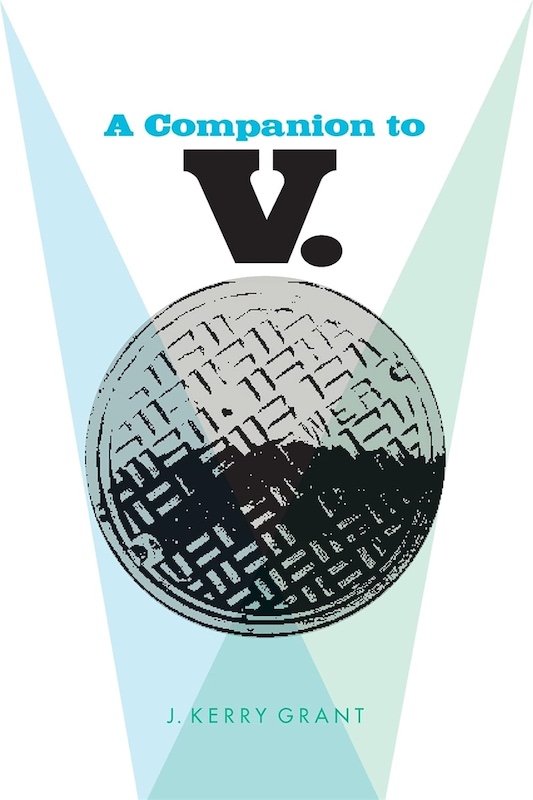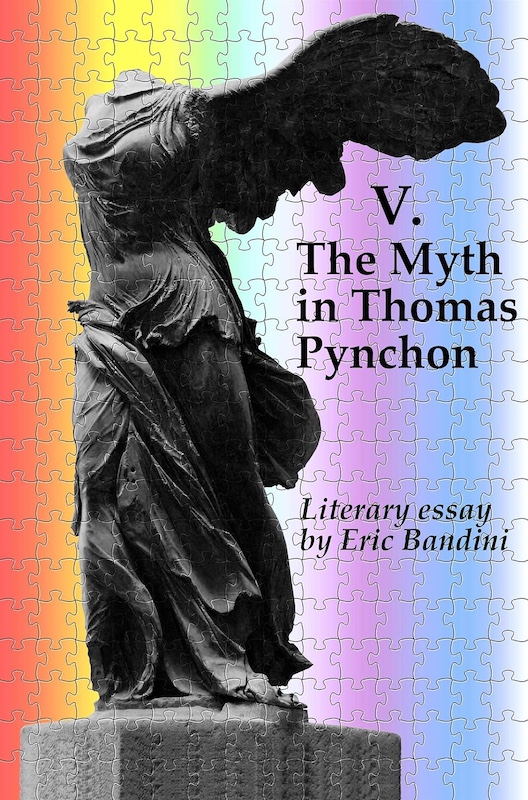Pynchon Criticism: “V.”
- At January 11, 2021
- By Spermatikos Logos
- In Pynchon, The Modern Word
 0
0
But it was a neat theory, and he was in love with it. The only consolation he drew from the present chaos was that his theory managed to explain it.
—“V.”
Pynchon Criticism: V.
This page collects essays, analysis, and guides centering on V., Pynchon’s first novel, published in 1963. Most of the books profiled in this section are accompanied by a brief description, a summary of contents, and the official publisher’s blurb. If any visitor would like to contribute informed commentary for any of these works, please contact Spermatikos Logos! The books are listed in chronological order of publication. Clicking the image of a book takes you directly to Amazon.
A Companion to V.
University of Georgia Press, 2001
Although not as challenging to a beginning reader as Gravity’s Rainbow or Mason & Dixon, Pynchon’s first novel, V., is still epic in scope: with over 150 characters, it sprawls across dozens of exotic locales and covers the better part of a century. Additionally, as with most of Pynchon’s work, V. is open-ended, defying traditional expectations of plot development and closure. It is therefore neither an easy book to read nor a simple one to understand, and until now, the general reader was forced to go it alone, as most Pynchon guides focus on Gravity’s Rainbow. (Though Tim Ware’s online guide to V. has always been a terrific resource!)
J. Kerry Grant has stepped in to fill this void with A Companion to V., an attractive volume that will please both beginner and scholar alike. Author of A Companion to “The Crying of Lot 49,” Grant follows in the noble footsteps of Steven Weisenburger (with Gravity’s Rainbow) and Don Gifford (with Joyce’s Ulysses), producing a volume of annotations which both gloss unfamiliar terms as well as stimulate deeper analysis. Beginning with a short introduction, Grant points out that Pynchon’s novel exists in a state between two very different characters, the static Profane and the maniacally-directed Stencil, and that readers are cut loose between these two poles to find their own bearings. Through his introduction and the annotations themselves, Grant makes it clear that he offers no definitive interpretation—his goal is to assist readers in the production of their own meanings. It’s here that Grant’s Companion really proves its worth. While the traditional glosses are certainly helpful: summarizing chapters, translating non-English passages, explaining Naval jargon, and elaborating on arcane historical situation; the real work is done in between these student aids. Character names are dissected for potential meanings, recurring themes are discussed and elaborated, intertextual allusions are highlighted and connected to a wide body of culture and literature, and even the smallest plot points serve as seeds for a variety of possible interpretations. Grant also remains sensitive to competing ideas, and his erudition is impressive—he makes frequent references to a wide spectrum of Pynchon criticism, from out-of-print books to online discussions culled from the Pynchon List.
Though A Companion to V. will certainly frustrate any reader looking for a definitive analysis of Pynchon’s enigmatic novel, to those wishing a deeper exploration of its many ideas and themes, Grant’s book is a fertile resource rich with charming details and provocative suggestions.
Summary & Study Guide V by Thomas Pynchon
A student guide to V., similar to the classic CliffsNotes guides that helped me plow through Silas Marner in 8th grade. Unlike CliffsNotes, BookRag guides only exist in digital form: this is the Kindle edition of the online version. Fortunately, the nameless author of the guide knows the novel is actually titled V.; but the cover and press materials omit the period. I added the period to the description below, because…. You know why. The same reason Hal’s mother brought a Sharpie to supermarket express checkout lanes to cross out less in “10 Items or Less” and change it to fewer.
Publisher’s Description: This study guide by BookRags.com, consists of approximately 48 pages of chapter summaries, character analysis, themes, and more—everything you need to sharpen your knowledge of V. by Thomas Pynchon. This comprehensive study guide includes the following sections written by BookRags.com: Plot Summary, Chapter Summaries & Analysis, Characters, Objects/Places, Themes, Style, and Topics for Discussion.
V. The Myth in Thomas Pynchon: Literary Essay
Self-Published, 2017
Eric Bandini is the pseudonym of an Italian writer who self-publishes essays on postmodernism and writers such as Thomas Pynchon, William Gaddis, and Philip K. Dick. Originally written in Italian as V. Il Mito in Thomas Pynchon, this “literary essay” focuses on Pynchon’s use of mythology in V. The English translation of this book only exists in digital form, and was made available for the Kindle in 2020. The translation was made by Bandini himself, who makes some persuasive points; but unfortunately he couches them in convoluted academic jargon that occasionally reads like a parody. He’s also fond of paragraph-long sentences that twist through a labyrinth of commas and clauses. While this is hardly surprising for a Pynchon scholar, Bandini tends to lose his reader along the way, his point becoming increasingly more obscure as the sentence ambles through a tangle of parentheses, brackets, italicization, and three different kinds of quotation marks. Maybe it’s an issue specific to the translation? Fortunately, the first few pages of the essay are available to preview at Amazon, allowing curious readers to make their own decision before diving in.
Pynchon Criticism:
[Main Page | General 1974–1999 | General 2000–Present | V. | Crying of Lot 49 | Gravity’s Rainbow | Mason & Dixon | Against the Day | Shorter Works | Contextual | Bibliography]
[Main Page | General 1974–1999 | General 2000–Present | V. | Crying of Lot 49 | Gravity’s Rainbow | Mason & Dixon | Against the Day | Shorter Works | Contextual | Bibliography]
Author: Allen B. Ruch
Last Modified: 3 September 2024
Main Pynchon Page: Spermatikos Logos
Contact:quail(at)shipwrecklibrary(dot)com
Last Modified: 3 September 2024
Main Pynchon Page: Spermatikos Logos
Contact:quail(at)shipwrecklibrary(dot)com




